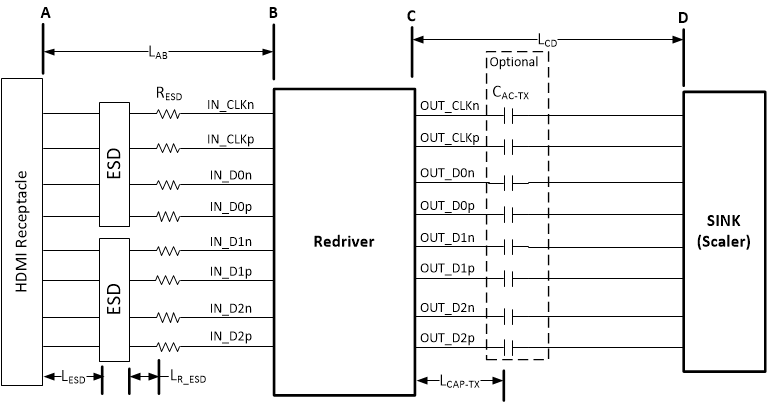SLLSFI6A july 2022 – july 2023 TDP1204
PRODUCTION DATA
- 1
- 1 Features
- 2 Applications
- 3 Description
- 4 Revision History
- 5 Pin Configuration and Functions
- 6 Specifications
- 7 Parameter Measurement Information
-
8 Detailed Description
- 8.1 Functional Block Diagram
- 8.2
Feature Description
- 8.2.1 4-Level Inputs
- 8.2.2 I/O Voltage Level Selection
- 8.2.3 HPD_OUT
- 8.2.4 Lane Control
- 8.2.5 Swap
- 8.2.6 Linear and Limited Redriver
- 8.2.7 Main Link Inputs
- 8.2.8 Receiver Equalizer
- 8.2.9 CTLE Bypass
- 8.2.10 Adaptive Equalization in HDMI 2.1 FRL
- 8.2.11 HDMI 2.1 Link Training Compatible Rx EQ
- 8.2.12 Input Signal Detect
- 8.2.13 Main Link Outputs
- 8.2.14 DDC Buffer
- 8.2.15 HDMI DDC Capacitance
- 8.2.16 DisplayPort
- 8.3
Device Functional Modes
- 8.3.1
MODE Control
- 8.3.1.1 I2C Mode (MODE = "F")
- 8.3.1.2
Pin Strap Modes
- 8.3.1.2.1 Pin-Strap: HDMI 1.4 and HDMI 2.0 Functional Description
- 8.3.1.2.2 Pin-Strap HDMI 2.1 Function (MODE = "0"): Fixed Rx EQ and DDC Buffer Enabled
- 8.3.1.2.3 Pin-Strap HDMI 2.1 Function (MODE = "1"): Flexible RX EQ and DDC Buffer Enabled
- 8.3.1.2.4 Pin-Strap HDMI 2.1 Function (MODE = "R"): Flexible Rx EQ and DDC Buffer Disabled
- 8.3.2 DDC Snoop Feature
- 8.3.3 Low Power States
- 8.3.1
MODE Control
- 8.4 Programming
- 8.5 Register Maps
- 9 Application and Implementation
- 10Device and Documentation Support
- 11Mechanical, Packaging, and Orderable Information
Package Options
Mechanical Data (Package|Pins)
- RNQ|40
Thermal pad, mechanical data (Package|Pins)
Orderable Information
9.3 Typical Sink-Side Application
Figure 9-9 shows a schematic representation of what is considered a standard sink implementation.
 Figure 9-9 TDP1204 in Sink
Side Application
Figure 9-9 TDP1204 in Sink
Side Application